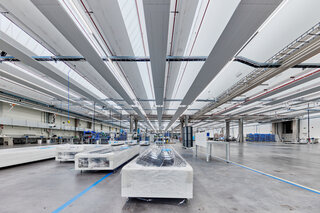
Energy-Efficient Cooling of Halls and Offices
How halls and offices can be cooled sustainably and efficiently using renewable energies.
The topic of cooling has become a key challenge in building services – not least due to global climate change also resulting in more frequent, ever more extreme temperatures and weather conditions in Central Europe. But when choosing the right cooling solution, planners and architects also have to think in terms of energy efficiency and sustainability. This blog post highlights possible solutions that create a comfortable working climate in large offices and industrial halls while protecting the environment and saving energy costs.

Open space offices, halls, etc. generally have a large room volume, extensive windows, and insufficient insulation, which results in high energy losses in terms of temperature control. Before looking for a suitable cooling system, interested parties have to ensure that their building fabric is insulated properly and that openings such as doors and windows are also sealed. This helps prevent unwelcome heat from entering in summer and heat loss in winter.
Operating cooling systems with renewable energies is not only environmentally friendly, but also plays a major role in saving energy costs. The connection of the cooling system to renewable energy sources, such as wind, water or solar energy, can be taken into consideration as early as the building planning phase. This combination requires the cooling system to be operated by electricity. In this case, machine exhaust heat or a heat pump can be used.

Central air conditioners
Split air conditioners
Variable refrigerant flow (VRF)
Ventilated underfloor cooling
Heating and cooling ceilings
Combination with modern control systems further optimises energy consumption, presenting an additional factor for lower operating costs.
When planning a cooling system, the focus is placed on user comfort. Air conditioners, for example, cool the air and create a high convection, which users often perceive as unpleasant. It is important to consider the specific demands of the building and the users and find tailored solutions. Heating and cooling ceilings work based on the natural radiation principle and therefore do not have to cool all air in the room to achieve a comfortable cooling effect on the skin.

If planners and architects enable cooling systems to be run in a well-insulated room with a cooling medium from a renewable source, everyone benefits: users from a comfortable room climate, the environment from reduced greenhouse gas emissions and the company from lower utility costs.